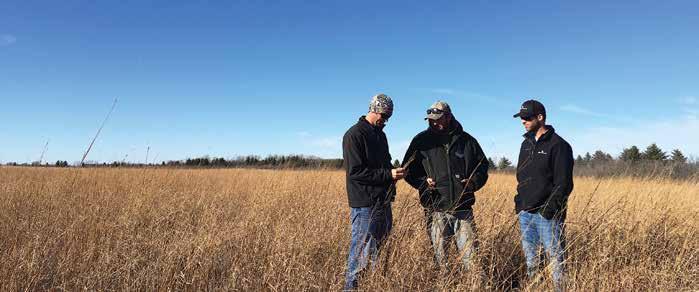
4 minute read
Seeds in Season
contributed article by Justin Fruechte, Forage & Cover Crop Specialist and Jared Knock, Business Development Millborn Seeds, Brookings, SD millbornseeds.com
PATHWAYS TO PERENNIALS
If you are a reader of The Stockman, we can pretty much guess where your passion lies. To you, four-legged bovines that eat grass are probably one of God’s most special creations, after people, and we agree! Nothing calms the soul as much as watching cattle graze on a still evening with nothing but the sounds of cows lowing to their calves and birds happily chirping, so long as you don’t witness one crawl through the fence during the process! Whether you grew up watching Westerns, were captivated by Captain Call and Gus starting a ranch in Montana, or are a diehard Yellowstone fan (or maybe all of the above), there is a pull to see the landscape around you enter into that timeless cycle. God provides rain, sunshine, and grass to nourish cows on your land, providing steers for beef and heifers for… more cows!
Frankly, though, the reality is that there have been incentives to plow up grass and farm in many parts of our country. Undoubtedly, some of this can be synergistic to raising livestock while selling most of the land’s bounty into other markets. But did you know there are also incentives to plant cropland back to grass?
Most landowners are aware of the CRP program, founded in 1985, to reduce erosion on degraded farmland and prop up unsustainably low commodity prices. But for stockmen, CRP holds a Catch-22. Land can generate revenue from growing grass through payments, but livestock cannot graze the ground annually—yielding more grass, but no additional cattle. While the CRP program remains the most dominant and best-known program for grass plantings, several other programs can provide incentives that, luckily, don’t discriminate against our bovine friends! At Millborn Seeds, we have compiled a list for at least 12 such programs in our home state of South Dakota, with most also available in other states. Every few weeks, we dig up another program, so there may well be more opportunities than those we list!
Here are three initiatives that are available to landowners in the upper Midwest beyond the CRP program.
NRCS EQIP 550 ENHANCEMENT
Range Planting 550 is a commonly used practice within EQIP and can be bundled with other programs like livestock water development and cross fencing for managed grazing. It is a one-time payment that varies by state and requires that the acres cost-shared stay in grass for ten years. There are cost shares for both introduced and native mixes, with the native mix practice paying out significantly better. There are very few restrictions on grazing once established. Native mixes are designed to replicate the native prairie’s flora that existed before cultivation and the introduction of non-native grass species. This program is available through your county NRCS office.
NRCS EQIP CONSERVATION COVER 327 ENHANCEMENT
In the days before the plow, the plains were a mix of native grasses and countless species of native forbs and flowers. If you have a small chunk of ground that you would like to experiment with establishing a highly diverse mix of wildflowers with native grass, this is an interesting option. There is compensation, varying in different states, for excluding use for five years as these diverse mixes get established. These mixes can commonly contain 30+ species for each seeding and provide a myriad of color throughout the growing season. This program is available through your county NRCS office.
THE SOIL HEALTH & INCOME PROTECTION PROGRAM (SHIPP)
This new program for 2020 was authorized in the 2018 Farm Bill. It is available for landowners in the Prairie Pothole states of North Dakota, South Dakota, Minnesota, Iowa, and Montana. Up to 15% of each field can be enrolled, and the base payment rate is 50% of the county farmland rental rate for three, four, or five years. Operators who qualify as Historically Underserved (HU) individuals are eligible for 75% of county rental rates as an annual payment. The program allows for haying or grazing outside of the primary nesting window for the area. There are no restrictions on which types of perennials can be planted, giving great flexibility to potential seed mixes. If you are interested, sign up would be through your local FSA office.

These programs, and many others, can help cost-share your efforts to match the landscape around you with your vision of harmony. The NRCS and wildlife and conservation non-profit organizations are eager to help you seed your corner of the prairie back to its natural state. If you have further questions about these programs, give one of our Forage + Cover Crop Specialists a call at (888)498-7333 or email us at info@millbornseeds. com. We can help you craft the perfect perennial mix from our inventory of 400+ species of native and improved grasses, forbs, and wildflowers. Additionally, we can explain some of the high-level details about these incentives and steer you in the right direction for more information!
learn more millbornseeds.com
The team of folks at Millborn Seeds have roots that run deep in farming, agriculture, and in the overall respect for the landscape. They opened their doors in 1987 and continue to walk alongside farmers, ranchers, and land owners across thousands of acres throughout the Midwest.









